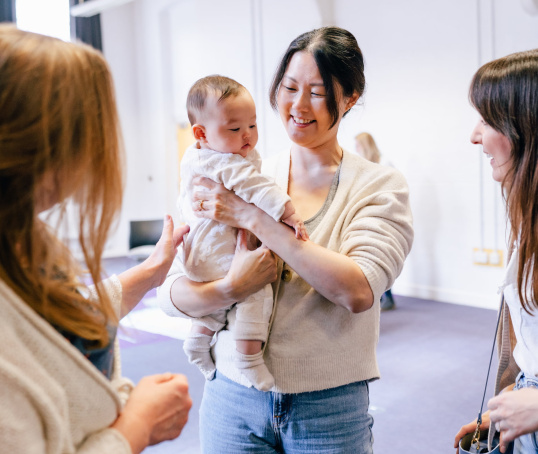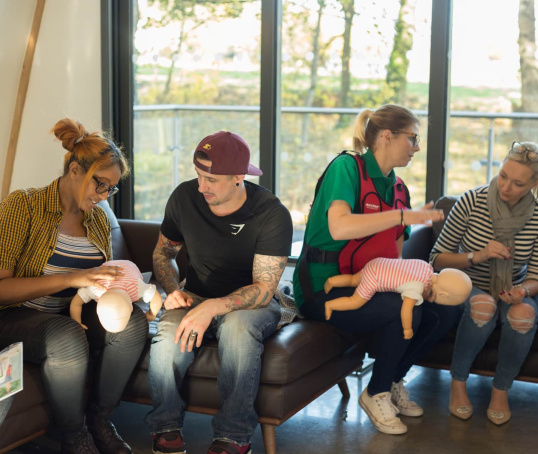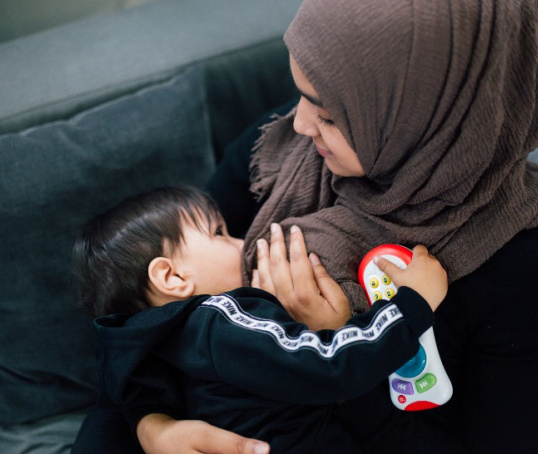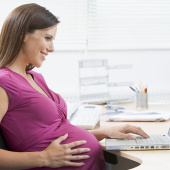Birth centres (midwife-led units) can be more homely than labour wards. We run you through what to expect when you have your baby there.
Birth centres or midwife-led units are run by – the clue’s in the name – midwives. They are also called midwifery units, birthing centres or birthing units. In Scotland they’re known as community maternity units (CMUs).
Birth centres can be alongside but separate from a hospital labour ward. They can also be in a different place completely so they’re freestanding. Birth centres don't have doctors to provide obstetric, neonatal or anaesthetic care on the premises.
As with labour wards, all midwife-led units are different. That means it’s a good idea to book a tour or ask your midwife in advance what facilities are available. This’ll give you an idea of what you can expect to happen on the day.
Research has shown that women who plan to give birth at home or in a birth centre have a higher likelihood of a straightforward vaginal birth (Scarf et al, 2018; Homer et al, 2019).
What will happen on arrival at the birth centre (midwife-led unit)?
Normally, when you arrive at the birth centre in labour, you’ll go to a private room. Here you might want to change into something cool, loose and comfortable as labour rooms tend to be warm.
If you are planning to use a birthing pool, you can choose to be naked or can bring something to wear in the water. You could wear a bikini or tankini or your normal bra. If you want to be a little more covered, you could choose a T-shirt or vest on top.
Your midwife will ask you what has happened so far and ask to examine you. This examination will include recording your temperature, pulse and blood pressure. They’ll also ask permission to feel your tummy to check the baby’s position and may offer to give you a vaginal examination (NHS, 2017).
This will help your midwife confirm whether you’re in active labour, which means you are having regular contractions and your cervix is dilated 4cm or more. If you’re not in active labour, they might suggest you return home until labour progresses a bit more (NICE, 2014).
Unless a labouring person has been advised to attend early, it is beneficial to stay at home until labour is established. Labouring women who are admitted to hospital in early labour are more likely to experience several medical procedures involving themselves and their babies, as well as longer hospital stays (Miller et al, 2020).
What facilities will the birth centre (midwife-led unit) provide?
The ethos of birth centres is to treat labour and birth as a straightforward, normal thing to happen, rather than a risky event (NCT, 2011). This means birth centre rooms are set up with furniture and facilities designed to help you feel calm and in control. They are usually low-tech rooms with calm interiors, often with a more homely feel and better facilities for birth partners (NCT, 2011).
Different centres vary but many provide birth pools to help you use water to cope with pain (WHICH, 2018). Birth centres are also more likely than hospitals to have beanbags, pillows and mats, as well as a comfortable chair for birth partners.
You may be able to adjust the temperature and brightness how you choose. Birth centre rooms also have varying amounts of space for you to move around freely during labour (Newburn, 2003).
Another bonus is being less likely to have to share toilet and bathroom facilities with others in a birth centre than on a labour ward (NHS, 2018).
Care in labour
If you choose to give birth in a midwife-led centre or birth centre, a midwife will look after you. A second midwife or maternity support worker may also be there (NHS, 2018).
Birth centres mean you’re more likely to see the same midwife throughout your care than you would in a labour ward (NHS, 2018). But depending on the length of your labour, you’ll probably be cared for by more than one midwife as one shift ends and another begins.
If everything is going well, you might be left with your birth partner for a while, particularly during early labour. Yet you should never be left alone at a time that worries you and you should always be shown how to call for help if you need it (NICE, 2014; CQC, 2018).
Your midwife should encourage you and help you to:
- move around and get into whatever positions you find most comfortable throughout labour
- have support from a birth partner of your choice
- feel that you are in control, listened to and being cared for with compassion
- keep eating and drinking (if you want to) in most cases
- use coping skills and pain relief techniques that you’ve planned, such as breathing, relaxation, massage, acupuncture, acupressure, hypnosis and playing music of your choice
- talk to you about the risks, benefits and implications for labour of pain relief such as gas and air and opiates
- offer you the opportunity to labour in water.
(NICE, 2014)
If you have made a birth plan, ensure that you or your birth partner share it with your midwife to start with so they know your wishes (NICE, 2014).
Transfers to hospital
If you have any complications, your midwife might say you need to be transferred to the nearest labour ward for a doctor to monitor you (NICE, 2014). Research shows that transfer rates vary and are higher for first time mothers.
In one study, a third (36%) to half (45%) of healthy women with straightforward pregnancies who planned first births at home or in birth centres later transferred (Kings College, 2014). But a more recent study of 3884 women in Ireland found that 14.6% transferred to hospital care during labour or after birth (Dencker et al, 2017).
Most women give birth in the place they had planned. Some women are transferred to hospital after labour has started. Some transfers are made before the baby is born and some after the baby has been born. Transfers are more likely for women having their first baby.
Some transfers are made because the woman has decided that she wants to move for a reason such as wanting different pain relief. Others are made on the advice of a midwife because of possible concerns about the woman or her baby, so that extra care is on hand if needed (NICE, 2014; Denker et al, 2017).
You’re less likely to need a transfer with subsequent labours. Only 10% of women having their second, third or fourth baby decide to transfer (Kings College, 2014).
What will happen during labour?
Once you are in active labour, you will be monitored in the same way to what would happen in a labour ward. Your midwife will check you every four hours or so to see how you're progressing, including taking your blood pressure, pulse and temperature (NICE, 2014). They’re there to support you emotionally as well as physically (NICE, 2014).
Your midwife will check your baby’s heartbeat more regularly, using a small handheld device to listen to their heart every 15 minutes. If you are labouring in water, your baby’s heart rate can be monitored with a waterproof Doppler. Alternatively, the midwife might ask you to move your bump above the water temporarily so a standard monitor can be used (Yinglin et al, 2014).
Your midwife will also regularly check the birthing pool water temperature. They’ll record any observations in your notes (NICE, 2014).
When it’s time and you’re ready to push your baby out, your midwife will help you find a comfortable position for giving birth (NICE, 2014). They will offer much more frequent observations and examinations at this stage, possibly listening to your baby’s heart rate every five minutes (NICE, 2014).
After the birth
When your baby makes an appearance, your midwife will continue to look after you and monitor you while you give birth to your placenta. They should encourage you to have skin-to-skin contact with your baby straight after birth. Skin-to-skin contact helps babies to start breastfeeding and protects against the negative effects of separation (NICE, 2014).
Your midwife should also recognise that the time immediately after the birth is when you and your birth partner are getting to know your baby. Midwives should make sure any interventions are sensitive to this. They should also keep separation to a minimum so you and your baby can be left to bond undisturbed as much as possible (NICE, 2014).
If you have a straightforward birth, you should be able to relax afterwards in the same room as where you gave birth.
You might be able to go home straight from the birth centre but this will vary from place to place (Guys and St Thomas’s, 2018). Some women choose to go home as soon as two to three hours after birth (Kings College Hospital, 2014). Don’t worry though, you don’t have to go if you are not feeling safe to do so.
If you need or want to stay longer, you will usually be moved to a postnatal ward where you’ll stay while you have checks and your care is planned. This is often a shared space or ward.
Often, your birth partner or whoever else who is looking after you will be able to stay with you as much as you want after the birth (CQC, 2018). Yet as different units have different policies in this area, it’s probably worth checking the policy beforehand.
This page was last reviewed in April 2021.
Further information
Our support line offers practical and emotional support with feeding your baby and general enquiries for parents, members and volunteers: 0300 330 0700.
We also offer antenatal courses which are a great way to find out more about pregnancy, labour and life with a new baby.
Make friends with other parents-to-be and new parents in your local area for support and friendship by seeing what NCT activities are happening nearby.
Care Quality Commission (CQC). (2018) NHS patient survey programme: 2017 survey of women’s experiences of maternity care. Available at: https://www.cqc.org.uk/sites/default/files/20180130_mat17_statisticalre… [Accessed 3rd April 2021].
Dencker A, Smith V, McCann C, Begley C. (2017) Midwife-led maternity care in Ireland – a retrospective cohort study. BMC Pregnancy and Childbirth. Available from: Midwife-led maternity care in Ireland – a retrospective cohort study [Accessed 3rd April 2021].
Guys and St Thomas's NHS Trust (2018) Once your baby has arrived. Available at: https://www.guysandstthomas.nhs.uk/our-services/maternity/after-your-ba… [Accessed 3rd April 2021].
Homer C, Cheah S, Rossiter C, Dahlen H, Ellwood D, Foureur M, Forster D, McLachan H, Oats J, Sibbritt D, Thornton C, Scarf V. (2019) Maternal and perinatal outcomes by planned place of birth in Australia 2000 – 2012: a linked population data study. BMJ. Available from: https://bmjopen.bmj.com/content/bmjopen/9/10/e029192.full.pdf [Accessed 29th March 2021].
Kings College Hospital (2014). Birth place decisions Information for women and partners on planning where to give birth. Available at: https://www.nhs.uk/Conditions/pregnancy-and-baby/Documents/Birth_place_… [Accessed 3rd April 2021].
National Institute for Health and Care Excellence (NICE) (2014) Intrapartum care for healthy women and babies (NICE Guideline 190). Available at: https://www.nice.org.uk/guidance/cg190 [Accessed 3rd April 2021].
NCT (2011) NCT Policy briefing: midwife-led units, community maternity units and birth centres. Available at: https://www.nct.org.uk/sites/default/files/related_documents/Midwife-le… [Accessed 3rd April 2021].
NHS (2017) What happens at the hospital or birth centre. Available at: https://www.nhs.uk/conditions/pregnancy-and-baby/hospital-birth-centre-… [Accessed 3rd April 2021].
NHS (2018) Your choice. Where to have your baby...Information for healthy, low-risk women having their first baby. Available at: https://assets.nhs.uk/prod/documents/NHSE-your-choice-where-to-have-bab… [Accessed 3rd April 2021].
Scarf V, Rossiter C, Vedam S, Dahlen H, Ellwood D, Forster D, Foureur M, McLachan H, Oats F, Sibbritt D, Thornton C, Homer C. (2018) Maternal and perinatal outcomes by planned place of birth among women with low-risk pregnancies in high-income countries: A systematic review and meta-analysis. Midwifery. Available from https://www.sciencedirect.com/science/article/pii/S0266613818300974. [Accessed29th March 2021].
Tommy's (2019) Packing your bag for labour and birth. Available at: https://www.tommys.org/pregnancy-information/labour-birth/packing-your-…. [Accessed 3rd April 2021].
Tommy's (2018) How to prepare for a water birth. Available at: https://www.tommys.org/pregnancy-information/labour-birth/where-can-i-g… [Accessed 3rd April 2021].
WHICH (2018) Birth centre. Available at: https://www.which.co.uk/birth-choice/your-maternity-options/birth-centre [Accessed 3rd April 2021].
Yinglin L,Yukun L, Xiuzhi H, Chuying D, Jing P,Peixian H, Jianping Z. (2014) A comparison of maternal and neonatal outcomes between water immersion during labor and conventional labor and delivery. Available at: https://www.ncbi.nlm.nih.gov/pmc/articles/PMC4019783/ [Accessed 3rd April 2021].






